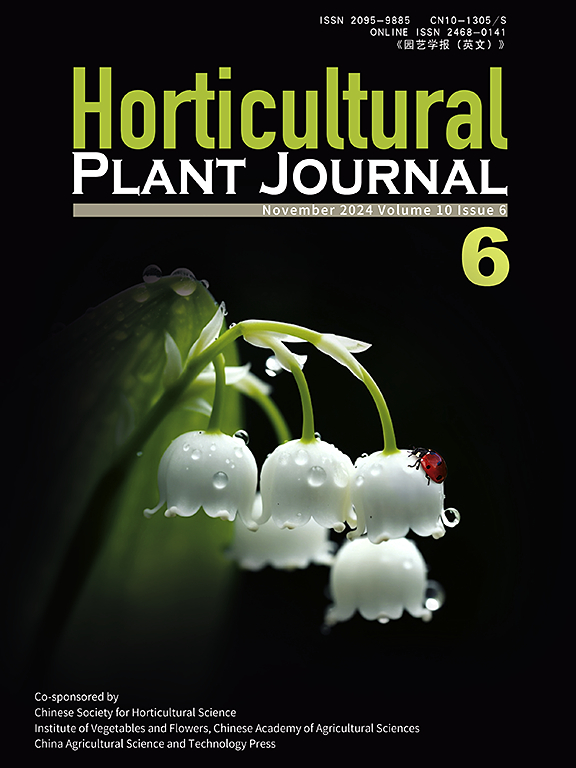综合代谢组学和转录组学分析揭示了四个驯化辣椒品种辣椒素和抗坏血酸生物合成的调控网络
IF 6.2
1区 农林科学
Q1 HORTICULTURE
引用次数: 0
摘要
辣椒是抗坏血酸含量高的蔬菜之一,含有独特的天然代谢物——辣椒素,它赋予了辣椒(辣椒)水果的辛辣味道。辣椒素和抗坏血酸的合成途径已经确定,但参与这些过程的基因很少被广泛研究或表征。本研究从4个栽培品种(C. annuum, C. bacaccatum, C. chinense和C. frutescens)的16个辣椒品系中鉴定了差异积累代谢物(DAMs)和差异表达基因(DEGs)。其中抗坏血酸含量最高的是PI656296,辣椒素和二氢辣椒素含量最高的是PI281435和PI195301。转录组测序(RNA-seq)数据加权基因共表达网络分析(WGCNA)鉴定出21个不同的基因模块。蓝色和绿松石色模块分别与辣椒素和抗坏血酸水平呈正相关。这些模块包括许多与辣椒素和抗坏血酸生物合成相关的候选转录因子(tf),包括先前报道的tf WRKY9和MYB108,以及来自WRKY、MYB、ERF和bHLH家族的tf。这些研究结果为辣椒类辣椒素和抗坏血酸合成的分子调控机制提供了重要见解,并为辣椒品种选择提供了重要信息。本文章由计算机程序翻译,如有差异,请以英文原文为准。
Comprehensive metabolomic and transcriptomic analyses reveal the regulatory network governing capsaicinoid and ascorbic acid biosynthesis in four domesticated Capsicum species
Peppers are among the vegetables with high ascorbic acid content and contain unique natural metabolites called capsaicinoids, which confer the spicy flavor of pepper (Capsicum annuum ) fruits. The synthetic pathways for capsaicinoids and ascorbic acid have been determined, but the genes involved in these processes have rarely been extensively researched or characterized. In this study, differentially accumulated metabolites (DAMs) and differentially expressed genes (DEGs) were identified across 16 pepper lines from four cultivated species (C. annuum , C. baccatum , C. chinense , and C. frutescens ). Of these lines, PI656296 had the highest ascorbic acid content, and PI281435 and PI195301 had the highest capsaicin and dihydrocapsaicin contents. Weighted gene coexpression network analysis (WGCNA) of transcriptome sequencing (RNA–seq) data identified 21 different gene modules. The blue and turquoise modules were positively correlated with the levels of capsaicinoids and ascorbic acid, respectively. These modules included numerous candidate transcription factors (TFs) related to capsaicinoid and ascorbic acid biosynthesis, including the previously reported TFs WRKY9 and MYB108, as well as TFs from the WRKY, MYB, ERF, and bHLH families. These findings provide important insights into the molecular regulation mechanisms of capsaicinoid and ascorbic acid synthesis in pepper and provide important information for pepper variety selection.
求助全文
通过发布文献求助,成功后即可免费获取论文全文。
去求助
来源期刊

Horticultural Plant Journal
Environmental Science-Ecology
CiteScore
9.60
自引率
14.00%
发文量
293
审稿时长
33 weeks
期刊介绍:
Horticultural Plant Journal (HPJ) is an OPEN ACCESS international journal. HPJ publishes research related to all horticultural plants, including fruits, vegetables, ornamental plants, tea plants, and medicinal plants, etc. The journal covers all aspects of horticultural crop sciences, including germplasm resources, genetics and breeding, tillage and cultivation, physiology and biochemistry, ecology, genomics, biotechnology, plant protection, postharvest processing, etc. Article types include Original research papers, Reviews, and Short communications.
 求助内容:
求助内容: 应助结果提醒方式:
应助结果提醒方式:


